Warning: pic heavy, as usual. 
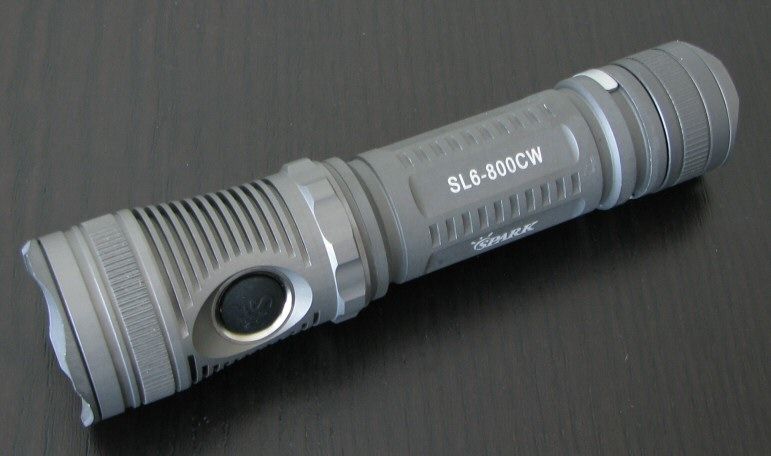
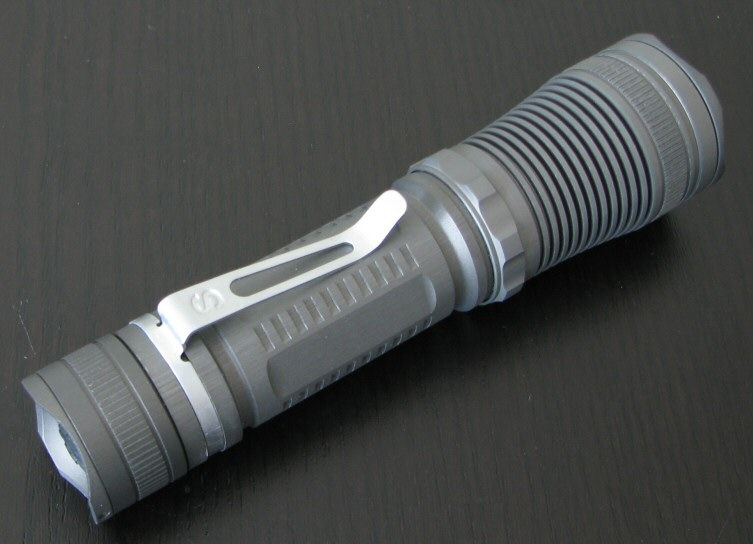
Spark is a relatively new manufacturer, best known for their relatively floody headlamps and handhelds. In this review, I will be examining their current top-of-the-line cool white handheld flashlight, the SL6-800CW (1x18650). Please see my ST5 headlamp review for a comparison.
Manufacturer Specifications:
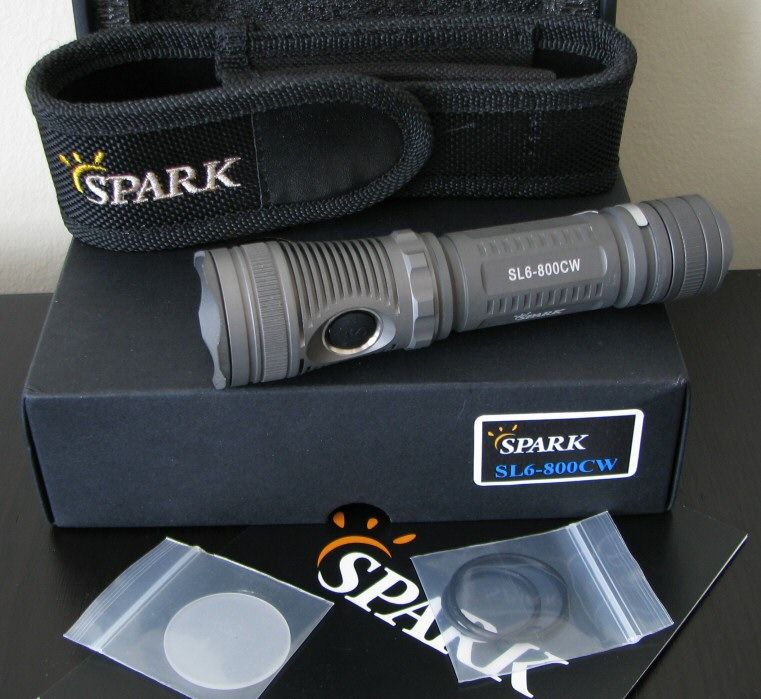
Inside the soft cardboard packaging box (with cut-out foam insert) you fill find the light, spare o-rings, frosted glass diffuser, manual, and good quality holster with closing flap.
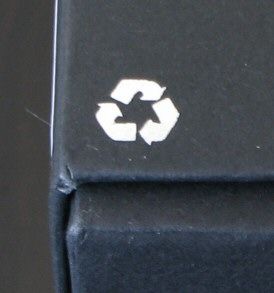
I like the commitment to supporting recycling. :thumbsup:
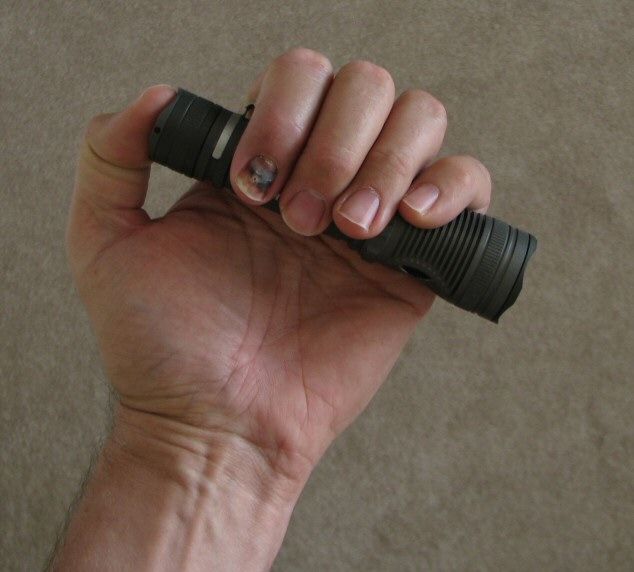
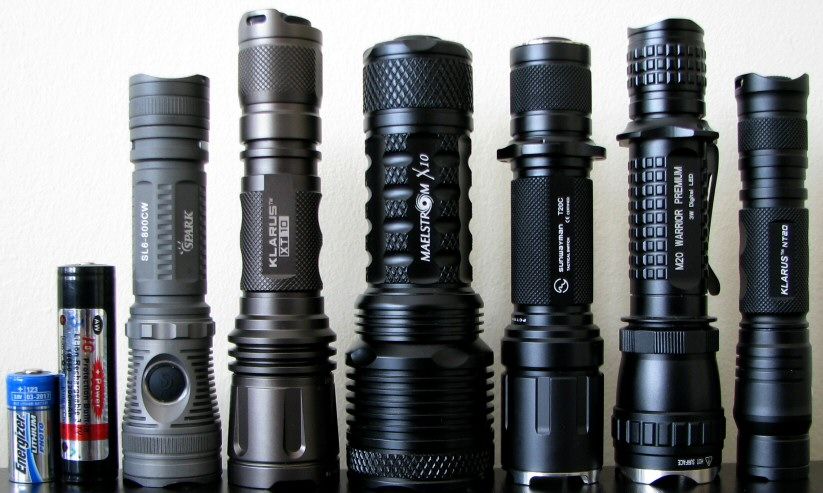
From left to right: Energizer CR123A, AW Protected 18650, Spark SL6 800CW, Klarus XT10, 4Sevens X10 Maelstrom, Sunwayman T20C, Olight M20, Klarus NT10
All weights with no batteries.
Spark SL6: Weight 77.8g, Length: 125.5mm, Width (bezel): 30.9mm
Klarus XT10: Weight 121.3g, Length: 144.8, Width (bezel) 34.9mm
Fenix TK15: Weight 131.1g, Length 147.1mm x Width (bezel) 34.0mm
Lumintop TD-15X: Weight 150.3g, Length 147.3mm, Width (bezel): 37.8mm
The SL6 is certainly a lot more compact than other XM-L-based lights I have come across.
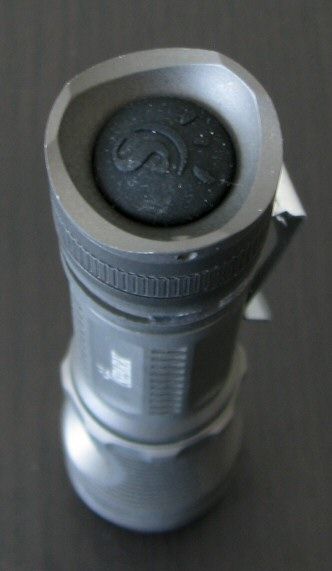
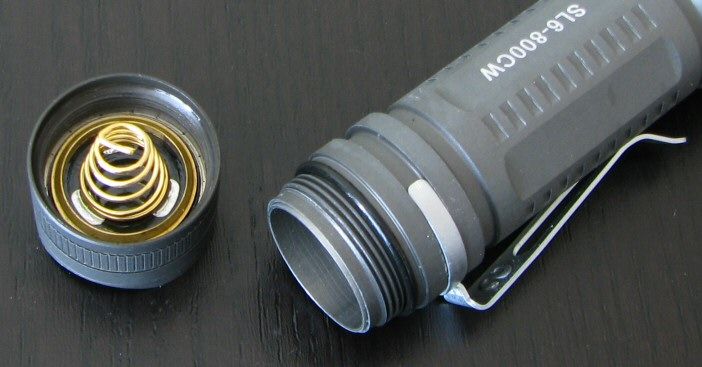
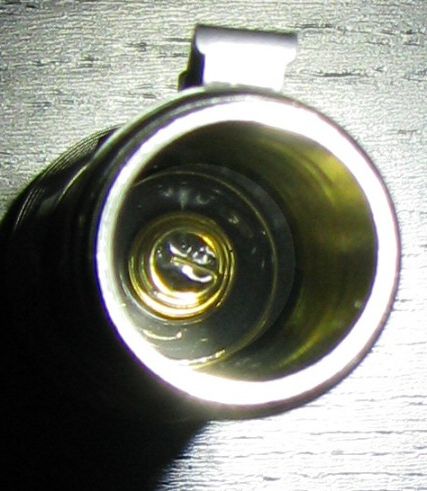
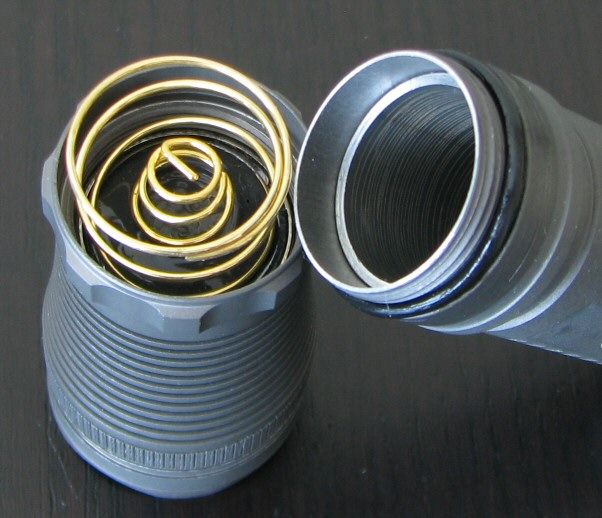
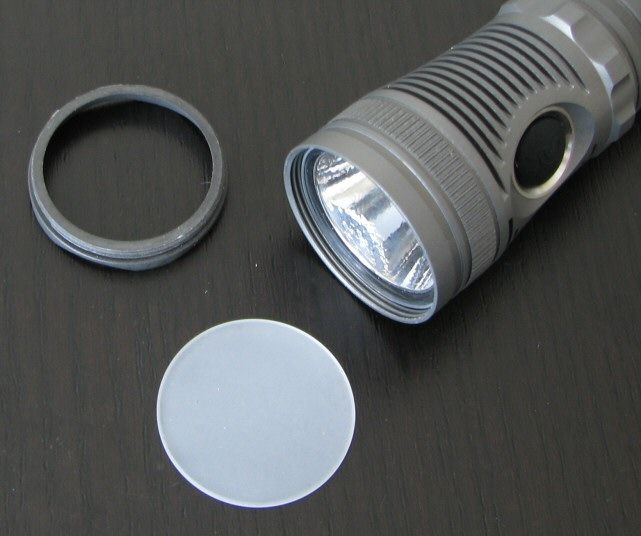
The build of the Spark SL6 is distinctive. To start, I like the muted gray natural anodizing (manufacturer claims hard anodized). There are some ridges in the anodizing on my sample, and some slight color mismatch between portions, but the overall affect is still good (think naturally-weathered looking, instead of blemished). Anodizing does seem fairly thinly coated, however.
Labels are fairly minimal and small, but clearly legible against the background.
There is no real knurling to speak of, but there are a number of body ridge details to help with grip. Screw threads are anodized for tailcap lock-out. :thumbsup:
The most distinctive part of the light is the dual-switch control. Although I've seen this before on a few lights (the original Klarus lights come to mind), the implementation here is different. To start, both switches are electronic ones (which explains the lower overall height). More significantly, they work interchangeably – you turn the light on/off or switch modes equally with either one. Feel is typical for electronic switches (think Zebralight ).
).
Note the large removable spring connecting the body to the head, presumably to connect the front switch to the tailcap switch.
Light can tailstand. Clip-on pocket clip is fairly typical in this class, and seems as firm as others I've seen. Note the clip is reversible, but you may scratch the anodizing if you try to remove and re-attach.
There is a spring on the positive contact board in the head, and all my flat-top high capacity cells fit and worked in the light.
I also like the included frosted glass diffuser (feels like glass, not plastic). This can be used to replace the clear lens, but I find it also fits over the existing lens assembly if you don't want to open everything up (i.e. just unscrew the bezel and pop on top). Note the bezel ring doesn't screw down all the way with both lenses in place, of course.
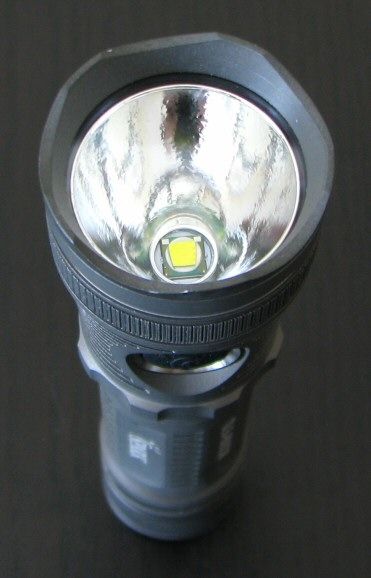
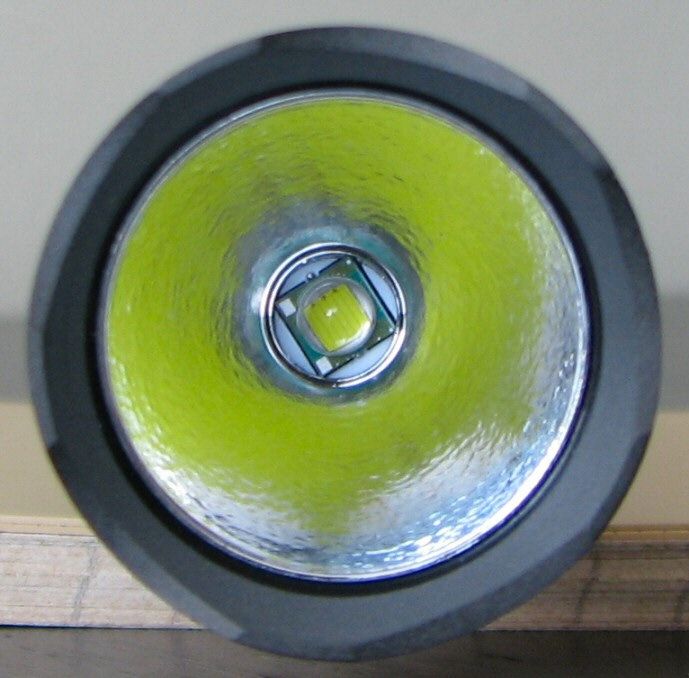
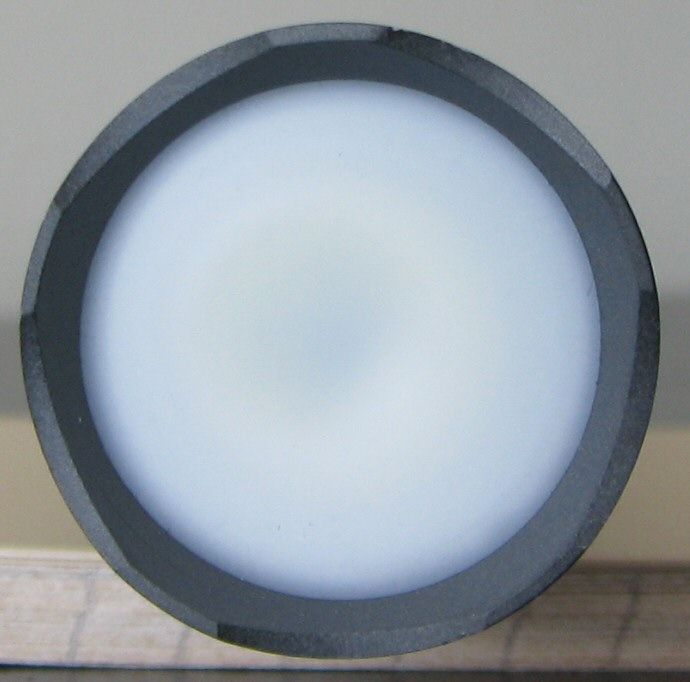
The SL6 has a narrow reflector with a fairly flat curvature (light OP coating), suggesting the light will not be a great thrower. XM-L emitter was well centered on my sample.
Which brings me to the white-wall beamshots. All lights are on AW protected 18650, about ~0.75 meter from a white wall (with the camera ~1.25 meters back from the wall). Automatic white balance on the camera, to minimize tint differences. All beamshots taken immediately upon activation.
All lights are on AW protected 18650, about ~0.75 meter from a white wall (with the camera ~1.25 meters back from the wall). Automatic white balance on the camera, to minimize tint differences. All beamshots taken immediately upon activation.
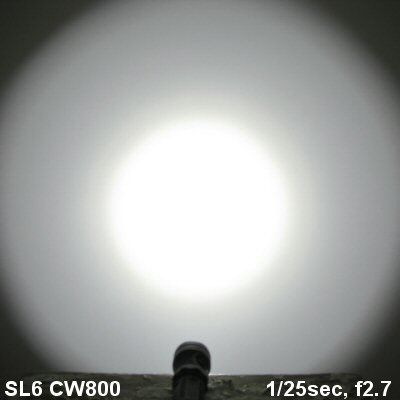
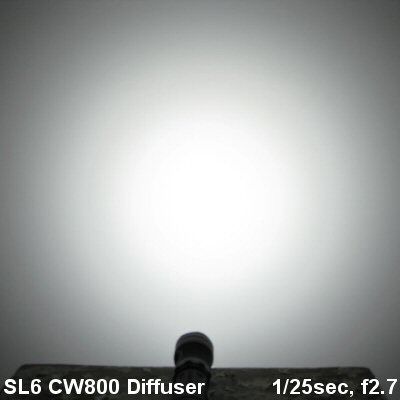
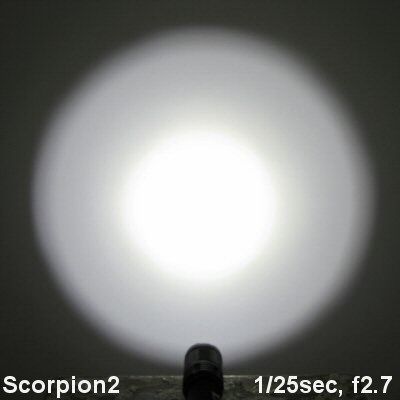
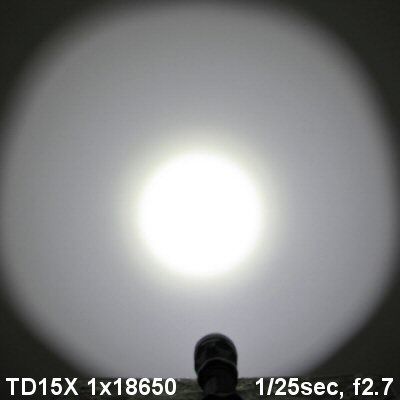
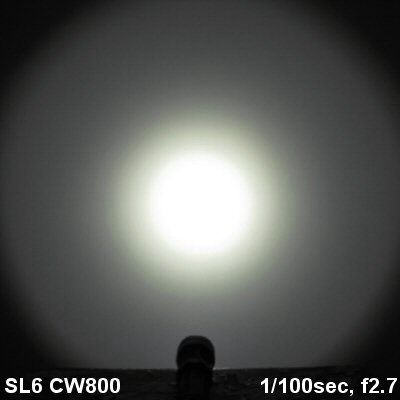
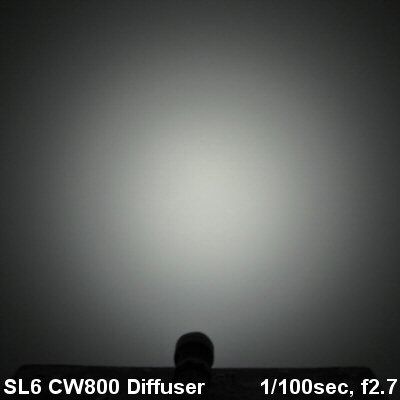
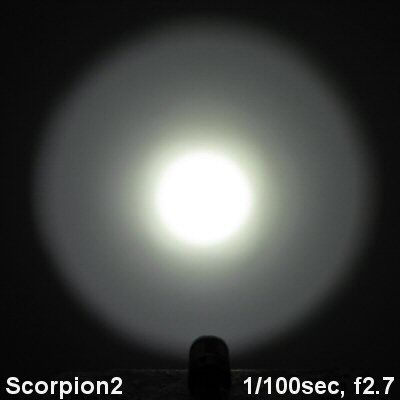
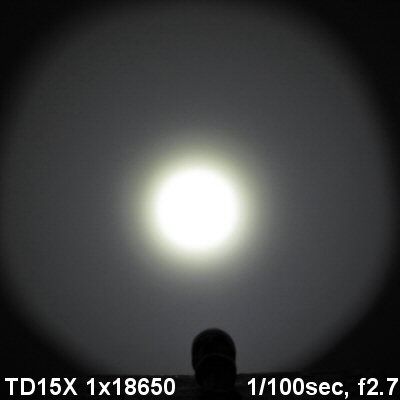
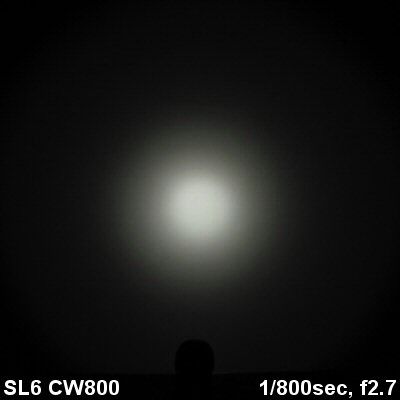
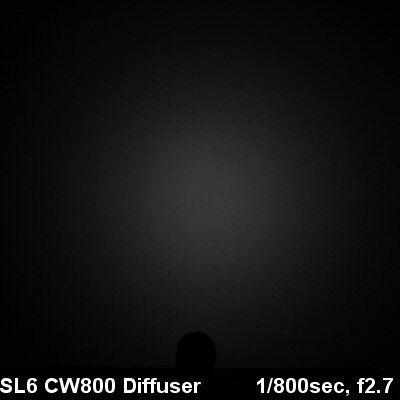
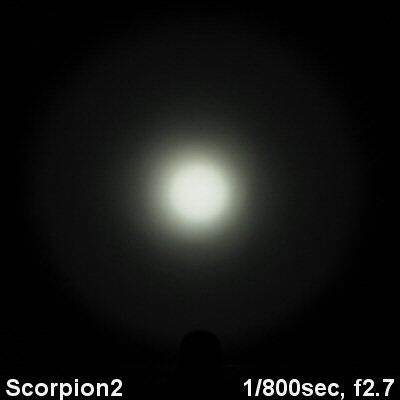
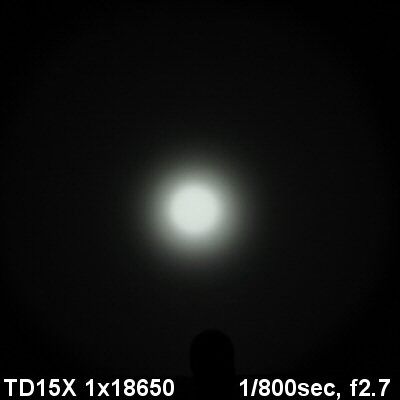
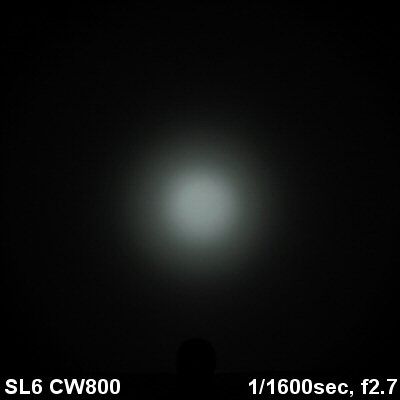
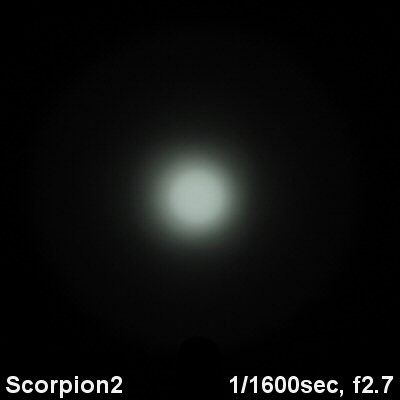
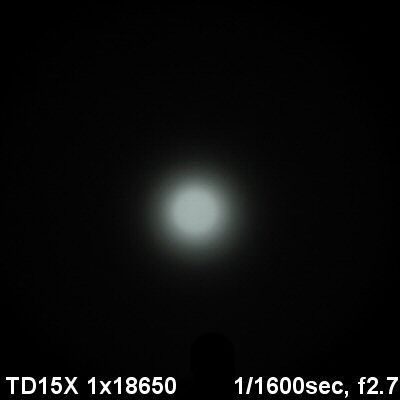
As expected, the beam profile is fairly floody, even without the frosted diffuser.
UPDATE AUGUST 21, 2011: I have now done 100-yard outdoor beamshots, in the style of my earlier 100-yard round-up reviews.
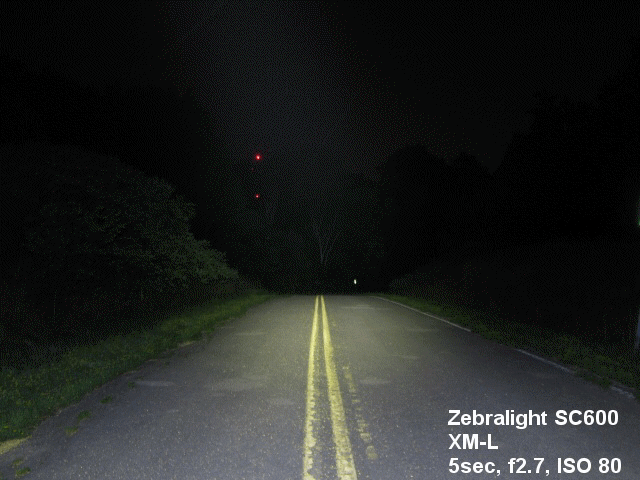
User Interface
Overall, the Spark SL6 has a similar user interface to the Zebralights.
I'll start with the main difference – the SL6 has dual electronic switches, which function inter-changeably (i.e., either one can be used for on/off or mode switching).
A quick click-release of either switch activates the light.
There are five modes to the SL6, four of which are accessed sequentially by holding down either switch (and letting go when the mode you want is reached). These are Lo – Med1 – Med2 – Hi, in repeating sequence.
The fifth constant output mode is called Super Hi, and is accessed by double-clicking the switch in any mode. Manufacturer claims LED is driven at 3.0A on Super Hi.
There are no strobe/SOS modes on the SL6.
The SL6 has mode memory, and remembers the last level used when re-activating the light. Note this memory is lost if you unscrew the tailcap (i.e. light starts up at its lowest setting after a battery change).
There is one quirk in the timing – you need to be quick on the press to activate the light. If you hold the switch for too long before releasing (i.e., half a second, as you might on a standard clicky), the light turns on and shuts off. :thinking: If you hold the switch for a second or more, the light comes on and cycles through the output levels. The timing reminds me of the Zebralight SC series (i.e. a quick press for Hi, a more sustained press for Lo). But it's odd that the more sustained press here results in the light turning on-off. :shrug:
UPDATE: Seems like this timing quirk was an intentional design, to allow for momentary signaling. While it works for this purpose, it is a bit tricky, as you need to get the timings just right (i.e. quick release for sustained on, longer hold before release for momentary on-off, and an even longer hold for ramping).
PWM/Strobe
UPDATE July 23, 2011: I had originally assumed the Lo and Med1 modes of the SL6 used high-frequency PWM, as I could detect a re-occuring signal on these levels only (i.e. no signal on Med2, Hi or Super).
Lo mode:
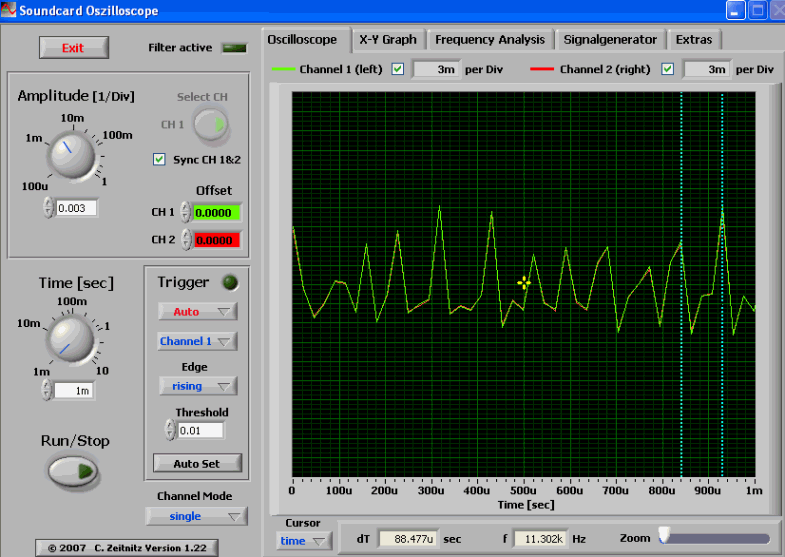
Med1 mode:
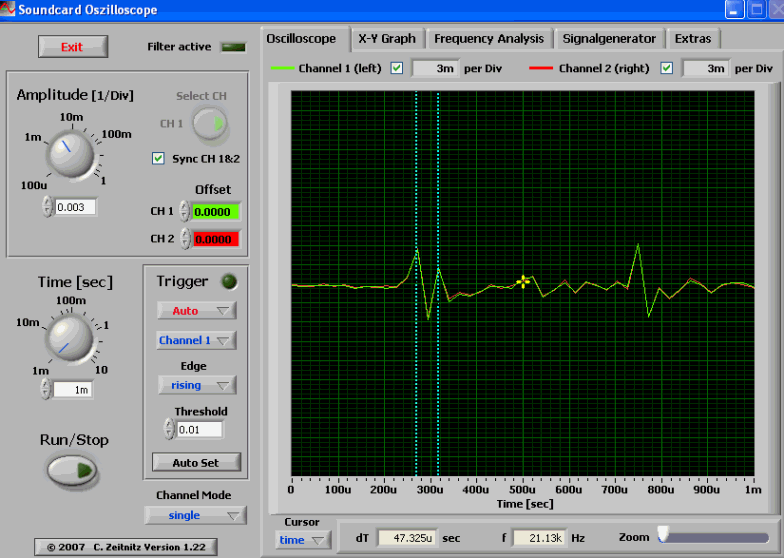
HKJ believes the SL6 is still current-regulated at these levels, but given the difficulties in providing high current regulation at a low current, the circuit overcompensates and produce a lot of high-frequency noise. As you can see in my traces as well, the frequency of this noise is quite variable, but is typically in a range of ~21kHz on Med1 and ~11kHz on Lo in my testing. This noise is completely undetectable by eye - you will not be able to observe any flickering on the lower outputs on the SL6. :thumbsup: And Spark confirms, their lights are fully current-controlled at all levels.
There are no strobe/SOS modes on the SL6.
Standby Current Drain
Due to the electronic switch nature of the light, the SL6 has a constant parasitic stand-by current drain when the tailcap is connected. However, I am unable to measure it at the tail. When I connect the leads (on my DMM's 10A port), the light cycles through output modes (i.e. it treats the DMM connection as a sustain button press). :shrug:
If I use the DMM's uAmA port, the light doesn't actually come on, but still seems to cycle between settings as the current ratings jump from a minimum of 65 uA to off the scale. Although hard to draw a conclusion from this, I suspect the standby drain is in the low uA range when off (i.e., <65 uA), which would translate into years of runtime for a standard 18650 cell.
As always, this current can be cut by simply unscrewing the tailcap a quarter turn when the light is not in use (which I recommend for all lights with a standby drain). But if you do this, the last output memory is erased and the light comes back on at is lowest setting.
Testing Method:
All my output numbers are relative for my home-made light box setup, a la Quickbeam's flashlightreviews.com method. You can directly compare all my relative output values from different reviews - i.e. an output value of "10" in one graph is the same as "10" in another. All runtimes are done under a cooling fan, except for any extended run Lo/Min modes (i.e. >12 hours) which are done without cooling.
I have recently devised a method for converting my lightbox relative output values (ROV) to estimated Lumens. See my How to convert Selfbuilt's Lighbox values to Lumens thread for more info.
Throw/Output Summary Chart:
Effective November 2010, I have revised my summary tables to match with the current ANSI FL-1 standard for flashlight testing. Please see http://www.sliderule.ca/FL1.htm for a description of the terms used in these tables.
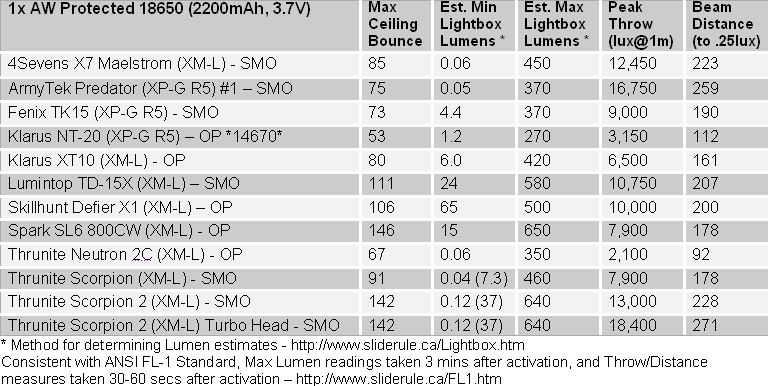
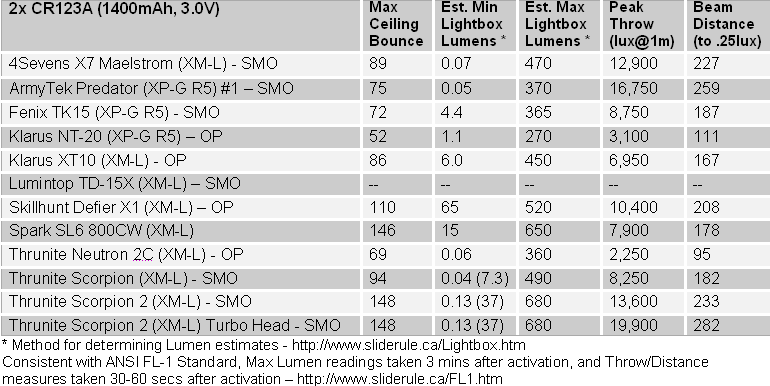
By ceiling bounce, the Super Hi output on the SL6 is marginally brighter than my Thrunite Scorpion V2 on 1x18650 (which is supposedly driven at 2.5A). oo: My lightbox reports them as being about the same, but I suspect the manufacturer's 3.0A current rating is believable. That's a lot of output from such a small light!
oo: My lightbox reports them as being about the same, but I suspect the manufacturer's 3.0A current rating is believable. That's a lot of output from such a small light!
Note however that the SL6 steps down to the Hi level after 5 mins runtime on Super Hi (see runtime charts below). I estimate the Hi level to be around ~420 lumens.
Output/Runtime Comparison:
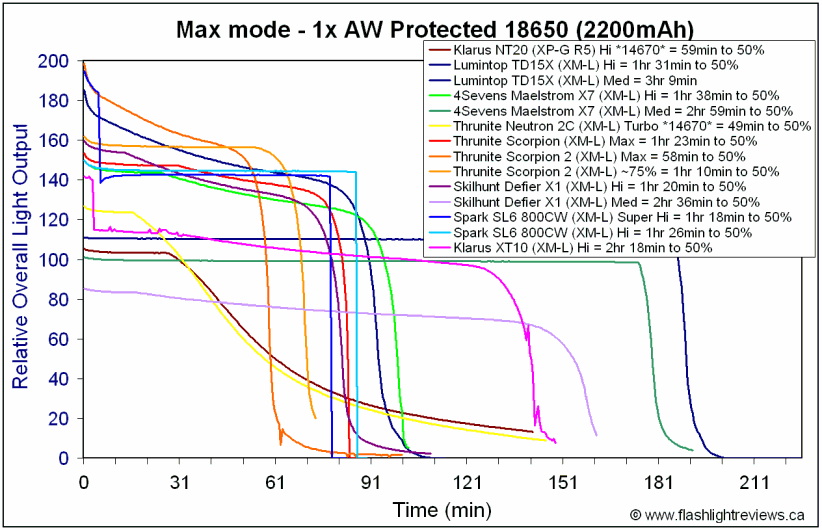
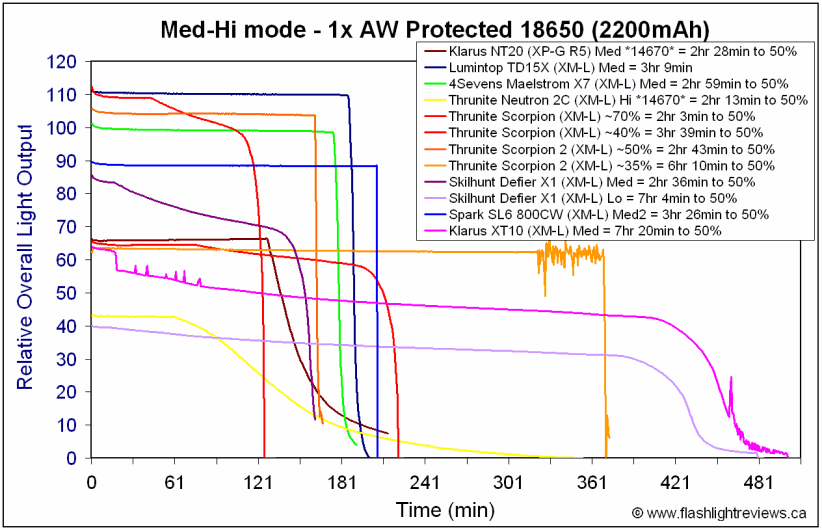
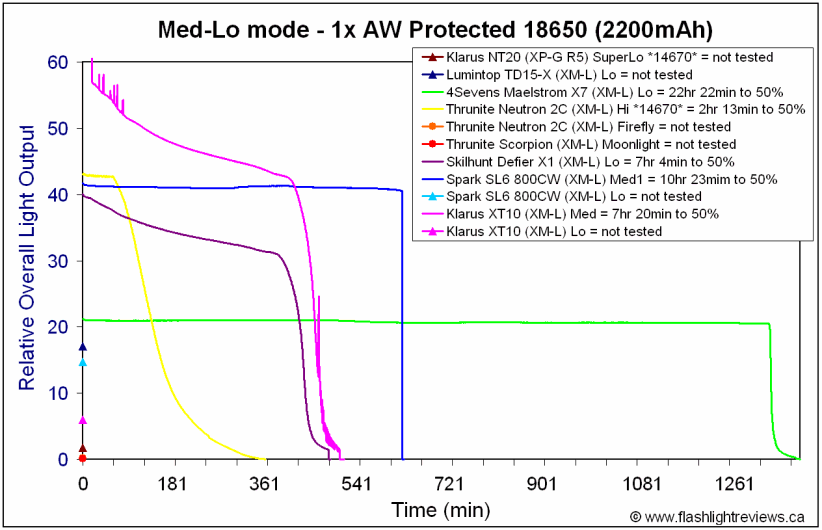
Note the fully-regulated pattern on 18650. Runtime is good at all levels tested.
For 2xCR123A runtimes below, I have included Super Hi – even though the manufacturer specifically warns against running the SL6 on Super Hi with CR123A.
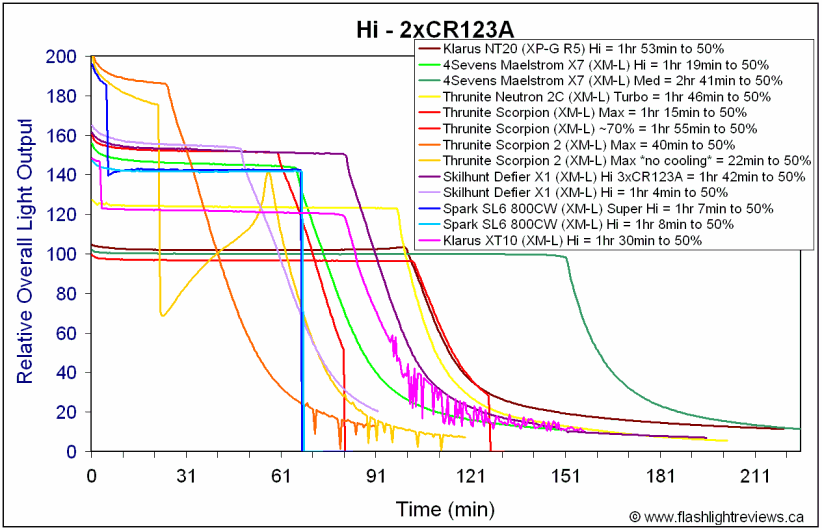
As you can see, in this case my Titanium Innovation cells handled the load without tripping their PTCs (under cooling). But I do not recommend you try this – especially given the small mass of the SL6. See my discussion thread on the drive current battery issue in the Thrunite Scorpion V2 for more general info on this matter.
Potential Issues
The SL6 doesn't take 2x 3.7V Li-ion sources.
It is not recommended to run 2xCR123A on Super Hi, due to the high discharge rate. Although my Titanium Innovation cells worked fine, my experience from the Thrunite Scorpion V2 tells me that many brands may trip their PTC circuits before the step-down to Hi occurs at 5 mins.
There are reports of some brands of 18650 not being able to handle the sustained discharge rate of Super Hi. My AW and Redilast cells all worked fine, however.
Switch timing takes a little getting used. Standard length click-release is "momentary mode", causing the light turn on/off for signalling. You need to be quick on the release for sustained on, or hold longer to activate the ramp.
There were initial reports of the rear tailcap switch not always working consistently with overly long cells, but this appears to have been resolved. I didn't experience any issues, even with my Redilast 2900mAh or 4GREER 2400mAh button-tops.
Preliminary Observations
It's almost a cliché here to say the light was smaller than I expected when it arrived – but the SL6 is definitely on the petite size for a 1x18650/2xCR123A class light. That said, it has good hand-feel and is comfortable to use in any orientation. :thumbsup:
That last point is enhanced by the unique dual-switch arrangement – where each switch functions interchangeably. You can single-handedly turn on/off and control all output modes easily by either switch, in whatever hand-grip you prefer (i.e. don't need to switch grip). This is remarkably versatile in practice – there's something for everyone here.
Aside from this innovation, the overall switch feel, UI and circuit functioning is very reminiscent of the Zebralight lights. Unlike the Zebralights, the SL6 is current-controlled at all levels below Max. Although there is some high frequency noise on the Lo/Med1 levels, the frequency is too high for you to be able to detect it visually. The only real issue I have is with the timing on the switches for on/off. Although the Zebralights also took a little getting used to (i.e. quick press for Hi, longer press for Lo), the fact that the SL6 shuts off on a longer press is unusual (i.e. need to do quick only, or a very long press to start the output ramping). :shrug:
The only real issue I have is with the timing on the switches for on/off. Although the Zebralights also took a little getting used to (i.e. quick press for Hi, longer press for Lo), the fact that the SL6 shuts off on a longer press is unusual (i.e. need to do quick only, or a very long press to start the output ramping). :shrug:
The drive level of the SL6 is clearly very high on Super Hi, consistent with the output of my Thrunite Scorpion V2. The step-down to Hi after 5 mins is a good safety feature, in my view. I also support the manufacturer's recommendation to only use Super Hi on 18650. The regular Hi level is still quite respectable, at around the level of most of my XM-L based 1x18650/2xCR123A-sized lights. :thumbsup:
Runtimes are good for the output levels, at all levels tested. Note the fully regulated pattern on 18650, likely due to lower voltage range of the circuit (i.e. multi-power lights rated to take 2x3.7V Li-ions are usually only semi-regulated on 1x3.7V sources).
The build, ergonomics, and features of the Spark SL6 are all good, IMO (although the switches do take some getting used to for timing). I also like the bundled frosted diffuser for added functionality. Although I have reviewed the Cool White 800CW model, a number of other emitter options are available (including Neutral tints). As long as you are thoughtful on how you attempt to run Super Hi, the SL6 could well serve your needs as a small powerhouse XM-L-based light.
----
Spark SL6 800CW provided by Spark for review.


Spark is a relatively new manufacturer, best known for their relatively floody headlamps and handhelds. In this review, I will be examining their current top-of-the-line cool white handheld flashlight, the SL6-800CW (1x18650). Please see my ST5 headlamp review for a comparison.
Manufacturer Specifications:
- LED: Cree XML T6 cool white
- 5 constant output modes
- Super: 800lm/0.7 hours
- Max: 500lm/1.4 hours
- Med2:220lm/3.5 hours
- Med1: 70lm/10 hours
- Low: 20lm/36 hours
- Battery: One 18650 rechargeable Li-on battery or two CR123A
- Reverse polarity accepted circuit
- Electrically conductive aluminum body provides inherent EMI/RFI shielding
- SCHOTT ultra clear lens
- Polarity reversibility
- IPX8 waterproof
- Weight: Without battery: 75g, With battery: 125g
- Dimension: Length: 125mm, Diameter: 31mm
- Premium grade aluminum alloy machined body with hard anodized finishing
- Impact resistance Lens with 98% transparency
- Operation:
- Single click on either the side or rear tailcap switch to turn the flashlight on & off.
- Hold onto either button to go through Minimum, Medium 1& Medium 2, Max modes. When desired mode is reached, release to stop brightness ramping and current mode is memorized.
- At any mode, quickly double click on button to trigger the Super mode. Super mode automatically steps down to Max mode after 5 minutes for protection.
- MSRP: ~$105

Inside the soft cardboard packaging box (with cut-out foam insert) you fill find the light, spare o-rings, frosted glass diffuser, manual, and good quality holster with closing flap.

I like the commitment to supporting recycling. :thumbsup:


From left to right: Energizer CR123A, AW Protected 18650, Spark SL6 800CW, Klarus XT10, 4Sevens X10 Maelstrom, Sunwayman T20C, Olight M20, Klarus NT10
All weights with no batteries.
Spark SL6: Weight 77.8g, Length: 125.5mm, Width (bezel): 30.9mm
Klarus XT10: Weight 121.3g, Length: 144.8, Width (bezel) 34.9mm
Fenix TK15: Weight 131.1g, Length 147.1mm x Width (bezel) 34.0mm
Lumintop TD-15X: Weight 150.3g, Length 147.3mm, Width (bezel): 37.8mm
The SL6 is certainly a lot more compact than other XM-L-based lights I have come across.





The build of the Spark SL6 is distinctive. To start, I like the muted gray natural anodizing (manufacturer claims hard anodized). There are some ridges in the anodizing on my sample, and some slight color mismatch between portions, but the overall affect is still good (think naturally-weathered looking, instead of blemished). Anodizing does seem fairly thinly coated, however.
Labels are fairly minimal and small, but clearly legible against the background.
There is no real knurling to speak of, but there are a number of body ridge details to help with grip. Screw threads are anodized for tailcap lock-out. :thumbsup:
The most distinctive part of the light is the dual-switch control. Although I've seen this before on a few lights (the original Klarus lights come to mind), the implementation here is different. To start, both switches are electronic ones (which explains the lower overall height). More significantly, they work interchangeably – you turn the light on/off or switch modes equally with either one. Feel is typical for electronic switches (think Zebralight
Note the large removable spring connecting the body to the head, presumably to connect the front switch to the tailcap switch.
Light can tailstand. Clip-on pocket clip is fairly typical in this class, and seems as firm as others I've seen. Note the clip is reversible, but you may scratch the anodizing if you try to remove and re-attach.
There is a spring on the positive contact board in the head, and all my flat-top high capacity cells fit and worked in the light.
I also like the included frosted glass diffuser (feels like glass, not plastic). This can be used to replace the clear lens, but I find it also fits over the existing lens assembly if you don't want to open everything up (i.e. just unscrew the bezel and pop on top). Note the bezel ring doesn't screw down all the way with both lenses in place, of course.



The SL6 has a narrow reflector with a fairly flat curvature (light OP coating), suggesting the light will not be a great thrower. XM-L emitter was well centered on my sample.
Which brings me to the white-wall beamshots.















As expected, the beam profile is fairly floody, even without the frosted diffuser.
UPDATE AUGUST 21, 2011: I have now done 100-yard outdoor beamshots, in the style of my earlier 100-yard round-up reviews.

User Interface
Overall, the Spark SL6 has a similar user interface to the Zebralights.
I'll start with the main difference – the SL6 has dual electronic switches, which function inter-changeably (i.e., either one can be used for on/off or mode switching).
A quick click-release of either switch activates the light.
There are five modes to the SL6, four of which are accessed sequentially by holding down either switch (and letting go when the mode you want is reached). These are Lo – Med1 – Med2 – Hi, in repeating sequence.
The fifth constant output mode is called Super Hi, and is accessed by double-clicking the switch in any mode. Manufacturer claims LED is driven at 3.0A on Super Hi.
There are no strobe/SOS modes on the SL6.
The SL6 has mode memory, and remembers the last level used when re-activating the light. Note this memory is lost if you unscrew the tailcap (i.e. light starts up at its lowest setting after a battery change).
There is one quirk in the timing – you need to be quick on the press to activate the light. If you hold the switch for too long before releasing (i.e., half a second, as you might on a standard clicky), the light turns on and shuts off. :thinking: If you hold the switch for a second or more, the light comes on and cycles through the output levels. The timing reminds me of the Zebralight SC series (i.e. a quick press for Hi, a more sustained press for Lo). But it's odd that the more sustained press here results in the light turning on-off. :shrug:
UPDATE: Seems like this timing quirk was an intentional design, to allow for momentary signaling. While it works for this purpose, it is a bit tricky, as you need to get the timings just right (i.e. quick release for sustained on, longer hold before release for momentary on-off, and an even longer hold for ramping).
PWM/Strobe
UPDATE July 23, 2011: I had originally assumed the Lo and Med1 modes of the SL6 used high-frequency PWM, as I could detect a re-occuring signal on these levels only (i.e. no signal on Med2, Hi or Super).
Lo mode:

Med1 mode:

HKJ believes the SL6 is still current-regulated at these levels, but given the difficulties in providing high current regulation at a low current, the circuit overcompensates and produce a lot of high-frequency noise. As you can see in my traces as well, the frequency of this noise is quite variable, but is typically in a range of ~21kHz on Med1 and ~11kHz on Lo in my testing. This noise is completely undetectable by eye - you will not be able to observe any flickering on the lower outputs on the SL6. :thumbsup: And Spark confirms, their lights are fully current-controlled at all levels.
There are no strobe/SOS modes on the SL6.
Standby Current Drain
Due to the electronic switch nature of the light, the SL6 has a constant parasitic stand-by current drain when the tailcap is connected. However, I am unable to measure it at the tail. When I connect the leads (on my DMM's 10A port), the light cycles through output modes (i.e. it treats the DMM connection as a sustain button press). :shrug:
If I use the DMM's uAmA port, the light doesn't actually come on, but still seems to cycle between settings as the current ratings jump from a minimum of 65 uA to off the scale. Although hard to draw a conclusion from this, I suspect the standby drain is in the low uA range when off (i.e., <65 uA), which would translate into years of runtime for a standard 18650 cell.
As always, this current can be cut by simply unscrewing the tailcap a quarter turn when the light is not in use (which I recommend for all lights with a standby drain). But if you do this, the last output memory is erased and the light comes back on at is lowest setting.
Testing Method:
All my output numbers are relative for my home-made light box setup, a la Quickbeam's flashlightreviews.com method. You can directly compare all my relative output values from different reviews - i.e. an output value of "10" in one graph is the same as "10" in another. All runtimes are done under a cooling fan, except for any extended run Lo/Min modes (i.e. >12 hours) which are done without cooling.
I have recently devised a method for converting my lightbox relative output values (ROV) to estimated Lumens. See my How to convert Selfbuilt's Lighbox values to Lumens thread for more info.
Throw/Output Summary Chart:
Effective November 2010, I have revised my summary tables to match with the current ANSI FL-1 standard for flashlight testing. Please see http://www.sliderule.ca/FL1.htm for a description of the terms used in these tables.


By ceiling bounce, the Super Hi output on the SL6 is marginally brighter than my Thrunite Scorpion V2 on 1x18650 (which is supposedly driven at 2.5A).
Note however that the SL6 steps down to the Hi level after 5 mins runtime on Super Hi (see runtime charts below). I estimate the Hi level to be around ~420 lumens.
Output/Runtime Comparison:



Note the fully-regulated pattern on 18650. Runtime is good at all levels tested.
For 2xCR123A runtimes below, I have included Super Hi – even though the manufacturer specifically warns against running the SL6 on Super Hi with CR123A.


As you can see, in this case my Titanium Innovation cells handled the load without tripping their PTCs (under cooling). But I do not recommend you try this – especially given the small mass of the SL6. See my discussion thread on the drive current battery issue in the Thrunite Scorpion V2 for more general info on this matter.
Potential Issues
The SL6 doesn't take 2x 3.7V Li-ion sources.
It is not recommended to run 2xCR123A on Super Hi, due to the high discharge rate. Although my Titanium Innovation cells worked fine, my experience from the Thrunite Scorpion V2 tells me that many brands may trip their PTC circuits before the step-down to Hi occurs at 5 mins.
There are reports of some brands of 18650 not being able to handle the sustained discharge rate of Super Hi. My AW and Redilast cells all worked fine, however.
Switch timing takes a little getting used. Standard length click-release is "momentary mode", causing the light turn on/off for signalling. You need to be quick on the release for sustained on, or hold longer to activate the ramp.
There were initial reports of the rear tailcap switch not always working consistently with overly long cells, but this appears to have been resolved. I didn't experience any issues, even with my Redilast 2900mAh or 4GREER 2400mAh button-tops.
Preliminary Observations
It's almost a cliché here to say the light was smaller than I expected when it arrived – but the SL6 is definitely on the petite size for a 1x18650/2xCR123A class light. That said, it has good hand-feel and is comfortable to use in any orientation. :thumbsup:
That last point is enhanced by the unique dual-switch arrangement – where each switch functions interchangeably. You can single-handedly turn on/off and control all output modes easily by either switch, in whatever hand-grip you prefer (i.e. don't need to switch grip). This is remarkably versatile in practice – there's something for everyone here.

Aside from this innovation, the overall switch feel, UI and circuit functioning is very reminiscent of the Zebralight lights. Unlike the Zebralights, the SL6 is current-controlled at all levels below Max. Although there is some high frequency noise on the Lo/Med1 levels, the frequency is too high for you to be able to detect it visually.
The drive level of the SL6 is clearly very high on Super Hi, consistent with the output of my Thrunite Scorpion V2. The step-down to Hi after 5 mins is a good safety feature, in my view. I also support the manufacturer's recommendation to only use Super Hi on 18650. The regular Hi level is still quite respectable, at around the level of most of my XM-L based 1x18650/2xCR123A-sized lights. :thumbsup:
Runtimes are good for the output levels, at all levels tested. Note the fully regulated pattern on 18650, likely due to lower voltage range of the circuit (i.e. multi-power lights rated to take 2x3.7V Li-ions are usually only semi-regulated on 1x3.7V sources).
The build, ergonomics, and features of the Spark SL6 are all good, IMO (although the switches do take some getting used to for timing). I also like the bundled frosted diffuser for added functionality. Although I have reviewed the Cool White 800CW model, a number of other emitter options are available (including Neutral tints). As long as you are thoughtful on how you attempt to run Super Hi, the SL6 could well serve your needs as a small powerhouse XM-L-based light.
----
Spark SL6 800CW provided by Spark for review.
Last edited:


 :laughing:
:laughing: Does the Beam show a Dounut Hole?
Does the Beam show a Dounut Hole?